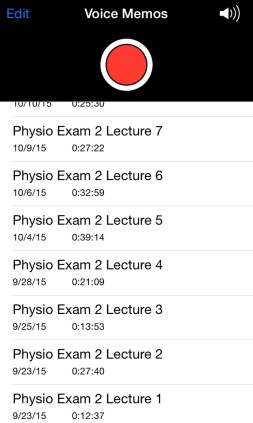This is part two of my four-part series on study strategies. In part one, I discussed time management and what I’ve been doing this semester to be more efficient and maximize my time. Yes, I’m still using my trusty log book, and yep, still counting hours. I’m telling you, it works! If you missed the post, check it out here. In today’s post, I’m going to focus on LEARNING the material. In a previous post, I mentioned that one of my preferred learning styles is auditory (see the post here). Knowing this, I decided to use this to my advantage for one of my classes. I decided Human Physiology would be the best fit for this. Having a part time job (I’ll discuss this in a future post), I knew I had to find ways to maximize the amount of information I learned AND retained within my scheduled study time. I also didn’t take human physio during undergrad, so this was certainly going to be an interesting experience. The goal was to:
1. Use my study time effectively
2. Understand core concepts and lecture material in advance of the exam. Essentially the day before the exam, I should be feeling confident on the material, and if possible, straight chilling. Absolutely NO panicking.
3. Ace those exams!
Using the method I explain below, I learned to study on the go. Most phones have a “voice memo” function, and as long as you have your phone and head/ear phones, you’re good to go.
Here’s what I did:
Step 1: Come to class prepared. This means powerpoint slides already printed (or for those with tablets, downloaded). This is particularly important since I took additional notes from lecture directly unto my slides. Coming to class prepared also meant my mind was mentally prepared. I’m not pulling out my phone to reply a text or go on Facebook, I am instead, listening intently to understand as much as I can so I spend less time later trying to understand what was thought.
Step 2: Within 24 hours, usually that evening or the next day, I reviewed my lecture slides and make sense of the additional notes I may have written on particular slides. I also made sure to clarify concepts I didn’t quite understand. Clarification usually meant looking up the specific concept on Khan Academy for a short and concise video on it.
Step 3: After reviewing my notes once, I could now record. I usually did this the next day. Literally, I would record myself going through each PowerPoint slide. Not just reading over the slide verbatim, but actually breaking it down as if I was teaching someone else. As I went through each slide, I could refer to other things I had mentioned. I was literally teaching myself in this recording.

Step 4: Listen to the recording over and over again. It was best if I could listen while looking at my slides. This way I could target both the visual and auditory part of learning. Most of the time though, it was pure listening.
- I listened to my recording while on the treadmill. My lecture notes would be mounted up so I could follow along (Side note: walking on 12.0 incline and 3.3 speed is the sweet spot for me)
- I listened while driving. I have about a 15 mins commute to school daily so on most days, I’ld listen to my recording.
- I listened at night.
- I listened in the morning.
- I listened while grocery shopping.
- I listened whenever I could.
It worked for me. The key thing was repetition. I kept listening to lectures over and over again to the point where I knew what would come next in the slide AND I understood what I was talking about. I used this strategy for the first two exams in my Human Physiology class. Having a part time job, I felt restricted with time. I HAD to be efficient with time.
How effective was it? Well this strategy was effective enough for me to get an A minus on my first two exams.
I find that recording myself going through the material is more effective that listening to a recording of the professor because: (1), There are no tangents, random discussions, or interruptions to lecture; (2), it’s a much shorter recording; (3) I explain concepts in words I understand, using examples I can relate to; (4) I get to talk it out, out loud – which is very important.
For my last two physio exams, I switched my study style to accommodate the increasing complexity of the material. I’ll talk more about that later in the series. I hope you find this strategy helpful. Try it out and let me know what you think!
Check out my other posts on study strategies:
Another great perspective to studying. I like how you incorporate it into pretty much everything. Repetition is key. Thanks a lot for sharing
LikeLike
I love the recording yourself going through lectures idea. I think I will definitely do that! Thanks for sharing. !!
LikeLike